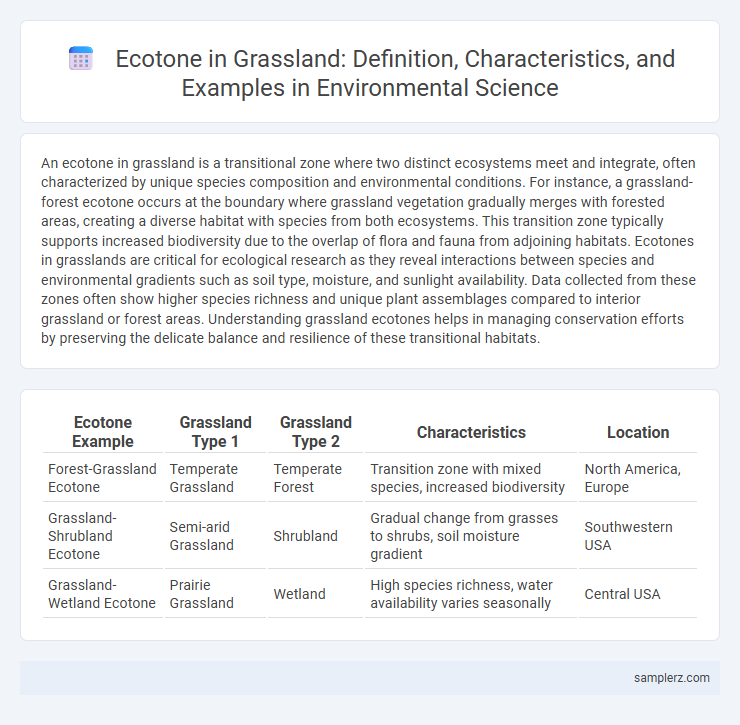An ecotone in grassland is a transitional zone where two distinct ecosystems meet and integrate, often characterized by unique species composition and environmental conditions. For instance, a grassland-forest ecotone occurs at the boundary where grassland vegetation gradually merges with forested areas, creating a diverse habitat with species from both ecosystems. This transition zone typically supports increased biodiversity due to the overlap of flora and fauna from adjoining habitats. Ecotones in grasslands are critical for ecological research as they reveal interactions between species and environmental gradients such as soil type, moisture, and sunlight availability. Data collected from these zones often show higher species richness and unique plant assemblages compared to interior grassland or forest areas. Understanding grassland ecotones helps in managing conservation efforts by preserving the delicate balance and resilience of these transitional habitats.
Table of Comparison
| Ecotone Example | Grassland Type 1 | Grassland Type 2 | Characteristics | Location |
|---|---|---|---|---|
| Forest-Grassland Ecotone | Temperate Grassland | Temperate Forest | Transition zone with mixed species, increased biodiversity | North America, Europe |
| Grassland-Shrubland Ecotone | Semi-arid Grassland | Shrubland | Gradual change from grasses to shrubs, soil moisture gradient | Southwestern USA |
| Grassland-Wetland Ecotone | Prairie Grassland | Wetland | High species richness, water availability varies seasonally | Central USA |
Introduction to Ecotones in Grassland Ecosystems
Ecotones in grassland ecosystems represent transitional zones where two distinct plant communities, such as prairie and woodland, converge, creating heightened biodiversity and unique ecological interactions. These areas support a diverse array of species adapted to variable conditions, fostering increased productivity and resilience within the landscape. Studying grassland ecotones offers valuable insights into habitat connectivity, species distribution, and the effects of environmental gradients on ecosystem dynamics.
Defining Ecotones and Their Ecological Importance
An ecotone in grassland ecosystems represents a transitional zone where two distinct habitats, such as grassland and forest, converge, creating a unique area with increased biodiversity and species interactions. These zones serve as critical ecological interfaces that support edge species, enhance genetic exchange, and facilitate adaptive responses to environmental changes. The dynamic nature of ecotones in grasslands contributes to ecosystem resilience, nutrient cycling, and habitat heterogeneity essential for sustaining diverse flora and fauna.
Prairie-Forest Transition Zones: Classic Grassland Ecotones
Prairie-forest transition zones exemplify classic grassland ecotones where tallgrass prairies meet temperate deciduous forests. These areas host high biodiversity due to the mixing of species from both ecosystems, influencing fire regimes, soil composition, and microclimates. Such ecotones are critical for studying habitat shifts driven by climate change and land management practices.
Riverbank Ecotones within Grassland Landscapes
Riverbank ecotones within grassland landscapes serve as critical transitional zones where aquatic and terrestrial ecosystems intersect, supporting high biodiversity and enhanced nutrient cycling. These ecotones stabilize soil, reduce erosion, and provide vital habitat for species such as amphibians, birds, and insects that rely on both water and grassland resources. The dynamic interface in riverbank ecotones fosters unique plant communities adapted to fluctuating moisture levels, promoting resilience against environmental changes.
Shrubland-Grassland Interfaces: Biodiversity Hotspots
Shrubland-grassland interfaces serve as critical ecotones, where the transition between shrub-dominated and grass-dominated ecosystems fosters high biodiversity due to the overlap of species from both habitats. These areas support diverse plant communities and provide habitat for numerous insects, birds, and small mammals, enhancing ecosystem resilience. Conservation of shrubland-grassland ecotones is essential for maintaining biological richness and ecological functions in temperate grassland regions.
Wetland-Grassland Edges as Ecotone Examples
Wetland-grassland edges represent a prime example of ecotones, where the transition between aquatic and terrestrial ecosystems creates a unique habitat with high biodiversity. These ecotones support diverse plant species such as sedges and rushes alongside grasses, providing critical breeding and feeding grounds for numerous bird and insect species. The dynamic water level fluctuations in wetland-grassland ecotones enhance nutrient cycling and contribute to ecosystem resilience against climate change impacts.
Human-Created Grassland Ecotones: Roadsides and Farmlands
Human-created grassland ecotones commonly occur along roadsides and farmlands, where the interface between natural grasslands and altered landscapes fosters diverse plant and insect species. These ecotones often support unique microhabitats due to variations in soil composition, moisture, and light exposure influenced by human activity. Roadsides serve as corridors for species migration and genetic exchange, while farmlands introduce edge effects that increase biodiversity within these transitional zones.
Wildlife Corridors through Grassland Ecotones
Grassland ecotones serve as critical wildlife corridors, enabling species to safely navigate between distinct habitats such as forests and open plains. These transitional zones support high biodiversity by offering diverse resources and cover, facilitating movement for mammals like deer and predators such as coyotes. Preserving grassland ecotones ensures connectivity in fragmented landscapes, promoting genetic exchange and ecosystem resilience.
Plant Species Diversity Across Grassland Ecotones
Grassland ecotones, transitional zones between prairie and forest or shrubland, exhibit high plant species diversity due to the overlap of species from adjacent ecosystems. These areas support a unique mix of grasses, forbs, and woody plants, such as big bluestem (Andropogon gerardii), purple coneflower (Echinacea purpurea), and eastern red cedar (Juniperus virginiana). The increased heterogeneity in soil moisture, light availability, and microclimate within these ecotones fosters coexistence and niche differentiation among numerous plant species.
Challenges and Conservation of Grassland Ecotones
Grassland ecotones, transitional zones between grasslands and other ecosystems, face challenges such as habitat fragmentation, invasive species encroachment, and altered fire regimes that disrupt native biodiversity. Conservation efforts prioritize maintaining ecological connectivity, controlling invasive species through targeted management, and implementing controlled burns to restore natural fire cycles crucial for ecosystem health. Effective monitoring and adaptive management strategies enhance resilience, supporting both species diversity and ecosystem services in grassland ecotones.

example of ecotone in grassland Infographic
 samplerz.com
samplerz.com